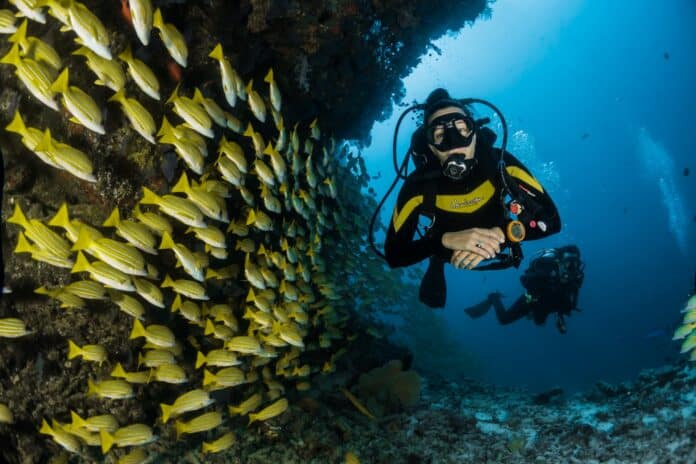Have you started SCUBA diving and thought that there’s no chance of you remembering all of these wacky acronyms that we use? Don’t worry, you’re not alone! Us diving instructors also had a hard time remembering these scuba acronyms when we first started. This is why we have created a handy, dandy SCUBA acronym guide to help you along the way!

Is SCUBA an acronym?
Firstly, let’s look at the most important acronym in the scuba diving world. The word SCUBA!
Many people ask what does scuba stand for and the answer is Self Contained Underwater Breathing Apparatus.
The term is widely believed to have been first used by Christian James Lambertsen in a patent submitted in 1952. He was primarily responsible for developing the United States Navy frogmen’s rebreathers in the early 1940s.
While scuba has now become the word for diving underwater, it actually first started out as an acronym for a piece of equipment.
S.C.U.B.A
This SCUBA set up allows divers to strap an air tank on their back and breathe from it underwater. With no need for hoses from the surface, this equipment is self-contained, hence the original name.
Read More: How Does Scuba Work?
The term ‘scuba’ has now evolved to describe the act of diving and using the equipment for diving.
Acronyms often used in Scuba Diving
Here are some common scuba acronyms that you will come across as a recreational diver. What others can you think of?
AAS
Alternate Air Source
This is the yellow hose with the 2nd stage regulator. This is used for emergencies.
ADT
Actual Dive Time
Is the time calculated that you were underwater.
BC or BCD
Buoyancy Compensator or Buoyancy Control Device
This is used to describe the jacket or wing that you wear to connect all of your equipment together. It controls your buoyancy and can be inflated or deflated.
Find out how scuba divers go up and down using their BCDs.
BWRAF
BCD, Weights, Releases, Air, Final Check
This acronym is used to describe the ‘Buddy Check’ before you enter the water. Using this helps you remember all of the steps.
CESA
Controlled Emergency Swimming Ascent
This ascent is practiced in your open water course. This ascent is used when you run out of air, your buddy is too far away to give you their AAS, and you are no deeper than 10 meters.
DIN
Deutsche Industry Norm
This is a type of valve system to connect your regulator to your tank. This is popular in cold water diving, and technical diving.
Check out the differences between DIN and Yoke valves.
DM
Dive Master
A dive master is the first professional level in the scuba industry. A DM will usually be your guide underwater.
DMT or DMC
Dive Master Trainee or Dive Master Candidate
An individual training to become a Dive Master.
dSMB
Delayed Surface Marker Buoy
This is a long tube, or safety sausage, that you inflate before you ascend from your dive. The surface marker buoy warns boats and other people that you will be coming up. This is attached to a reel or a lanyard that you hold onto.
EANx
Enriched Air Nitrox
This is a different blend of gas that we can breathe. It is used to describe oxygen levels higher than 21%.
IDC
Instructor Development Course.
For divers training to become an instructor.
LPI
Low Pressure Inflator
This connects your regulator to your BCD to deliver low pressure air to fill your BCD.
MSD
Master Scuba Diver
This is the highest scuba certification that is not a professional certification. It is not a professional title but it signifies that the diver has had extensive training and experience with a certifying agency.
Read More: Master Scuba Diver vs. Dive Master. What are the Differences?
NDL
No Decompression Limits
Recreational divers will dive within no-decompression limits. This means you do not need to make a decompression stop. The time is based on your depth and you need to follow this so you can keep your nitrogen absorption at a safe level.
Explained: What is an NDL, and Why is it Important?
RDP
Recreational Dive Planner
Remember that table with lots of numbers in it? This is the RDP and will help us calculate how long we can stay at a certain depth before we reach our NDL. Dive computers have now made these tables obsolete.
RNT
Residual Nitrogen Time
This tells us how much nitrogen we have in our body. Especially useful when figuring out depths and durations for our next dive.
SPG or PG
Submersible Pressure Gauge or Pressure Gauge
This is what you use to read how much air is left in your tank.

VENTID
Ventid is used to remember the symptoms of Oxygen Toxicity. Visual disturbances, Ear ringing, Nausea, Twitching, Irritability, and Dizziness.
Dive Agencies
You may have heard of these dive agencies but not have known what their acronyms meant. Here are a few. Which agency are you certified with?
PADI
Professional Association of Diving Instructors
SSI
Scuba Schools International
RAID
Rebreather Association of International Divers
NAUI
National Association of Underwater Instructors
Read More: NAUI vs. PADI: What Are The Differences?
SDI
Scuba Diving International
CMAS
Confédération Mondiale des Activités Subaquatiques
AIDA
Association Internationale pour le Développement de l’Apnée
BSAC
British Sub Aqua Club
Say What?
It’s funny that as scuba divers we don’t talk much underwater, and yet, we use so many acronyms and long phases for this activity. There’s definitely a lot to remember and think about when first starting out as a scuba diver. But luckily, once you’ve used these scuba acronyms a few times, it will become second nature!

Read More: Learn how to do the SAFEST Buddy Check and learn BWRAF Buddy Check Acronyms
What other acronyms do you use in scuba diving? Let us know in the comments below!
